Glycolic acid is effective in treating acne by clearing pores and reducing breakouts. This potent alpha hydroxy acid stimulates cell turnover and decreases sebum production, which are essential in preventing acne. It is recommended to start with lower concentrations to prevent irritation. Regular use not only helps in healing existing acne but also fades post-acne marks and improves skin tone. Dermatologists suggest combining it with a gentle cleanser and moisturizer, and always remember to apply sunscreen to protect your skin. If you are interested in incorporating glycolic acid into your skincare routine, you will find valuable tips to enhance its benefits.
Key Takeaways
- Glycolic acid promotes cell turnover, helping to unclog pores and prevent acne breakouts.
- Its anti-inflammatory properties reduce breakout frequency and improve overall skin tone.
- Regular use can fade post-acne marks and enhance skin texture.
- Dermatologists recommend starting with low concentrations to minimize irritation while achieving results.
Understanding Glycolic Acid
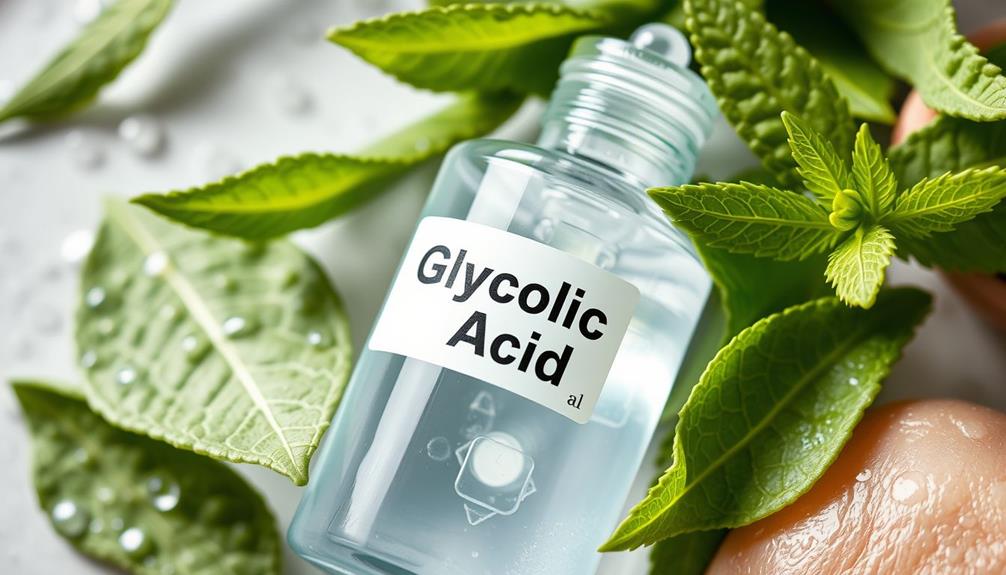
Glycolic acid, a powerful alpha hydroxy acid derived from sugar cane, works wonders as a chemical exfoliant by breaking down dead skin cell bonds to reveal fresher, healthier skin. Its small molecular size allows for deep penetration, enhancing cell turnover and greatly improving your skin texture.
By effectively loosening dead skin cells, glycolic acid promotes a smoother surface, making it beneficial for those dealing with acne and its aftermath. Additionally, incorporating essential oils for skin can further enhance your skincare routine by providing nourishment and antimicrobial benefits.
As you incorporate glycolic acid into your skincare routine, you'll notice its ability to reduce dark spots and hyperpigmentation. This is due to its exfoliating properties that help slough away the outer layer of your skin, revealing a more even skin tone underneath.
Plus, glycolic acid also minimizes the appearance of fine lines, giving your complexion a youthful glow. Unlike beta hydroxy acids, glycolic acid is water-soluble and works primarily on the skin's surface, making it suitable for various skin types.
Benefits for Acne Treatment

Using glycolic acid in your skincare routine offers numerous benefits for treating acne, from reducing lesions to improving skin texture.
This powerful ingredient works through its exfoliating action, promoting cell turnover that helps unclog pores and prevent future breakouts. Dermatologists often recommend glycolic acid for individuals with mild to moderate acne, highlighting its role in decreasing sebum production, which is a key factor in acne formation.
Additionally, maintaining a clean indoor environment with an ozone air purifier can further support your skin health by reducing airborne allergens that may contribute to breakouts.
Not only does glycolic acid target active lesions, but it also helps fade post-acne marks and hyperpigmentation, ultimately improving skin tone. Its anti-inflammatory properties further assist in reducing the frequency of breakouts, making it a well-rounded option for acne treatment.
Regular use of glycolic acid-based products can greatly enhance your skin's overall appearance, leaving it smoother and clearer.
Incorporating glycolic acid into your routine may be a game-changer for your acne journey. Just remember to start slowly and consider consulting with a dermatologist to find the right products and concentrations for your skin type.
Embrace the benefits of glycolic acid, and watch your skin transform.
Clinical Evidence and Studies

Numerous clinical studies confirm the effectiveness of glycolic acid as a treatment for acne, showcasing its ability to greatly reduce lesions and improve skin texture.
Research published in the Journal of the American Academy of Dermatology found that regular use of glycolic acid considerably diminished acne lesions in participants.
Additionally, findings from the Journal of Cosmetic Dermatology highlighted that glycolic acid peels not only reduced sebum production but also enhanced overall skin texture.
Incorporating essential oils for skin benefits into your skincare routine can complement the effects of glycolic acid, as certain oils have antimicrobial properties that may further alleviate acne symptoms.
These clinical findings indicate that glycolic acid serves as an effective adjunctive treatment for acne, resulting in a notable decrease in overall acne severity.
Participants consistently reported an improvement in skin clarity and a reduction in inflammation following glycolic acid treatments.
The efficacy of glycolic acid has been supported by multiple peer-reviewed studies, underscoring its role as a valuable component in acne treatment regimens.
Incorporating glycolic acid into your skincare routine can yield substantial benefits, making it a compelling option for those struggling with acne.
Whether through topical applications or chemical peels, this ingredient offers a scientifically-backed approach to achieving clearer, healthier skin.
Expert Dermatologist Opinions
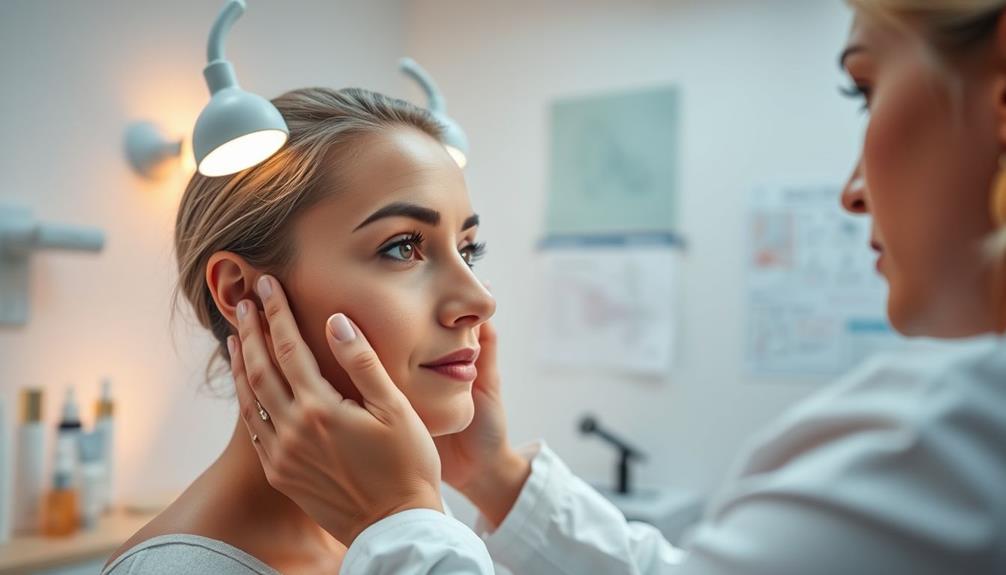
Experts in dermatology widely acknowledge the benefits of glycolic acid for treating mild to moderate acne, particularly for its ability to unclog pores and reduce inflammation.
This aligns with the understanding that certain ingredients can notably influence skin health, much like how self-perception influenced by astrological beliefs can enhance confidence.
Renowned dermatologists, like Dr. Bottiglione, emphasize the importance of using glycolic acid as part of a thorough treatment plan. Here's what they recommend:
- Start with lower concentrations to minimize irritation.
- Combine glycolic acid with gentle cleansing for ideal results.
- Incorporate moisturizing products to maintain skin hydration.
- Monitor your skin's response and adjust as needed.
Clinical studies back these expert opinions, showing considerable reductions in acne lesions with regular glycolic acid use.
However, individual responses can vary, making it essential to tailor your approach to your specific skin type.
Dermatologists stress that consistent application within your skincare routine can enhance the effectiveness of glycolic acid.
By understanding how to use it properly, you can achieve better outcomes in your battle against acne.
Incorporating Into Skincare Routine
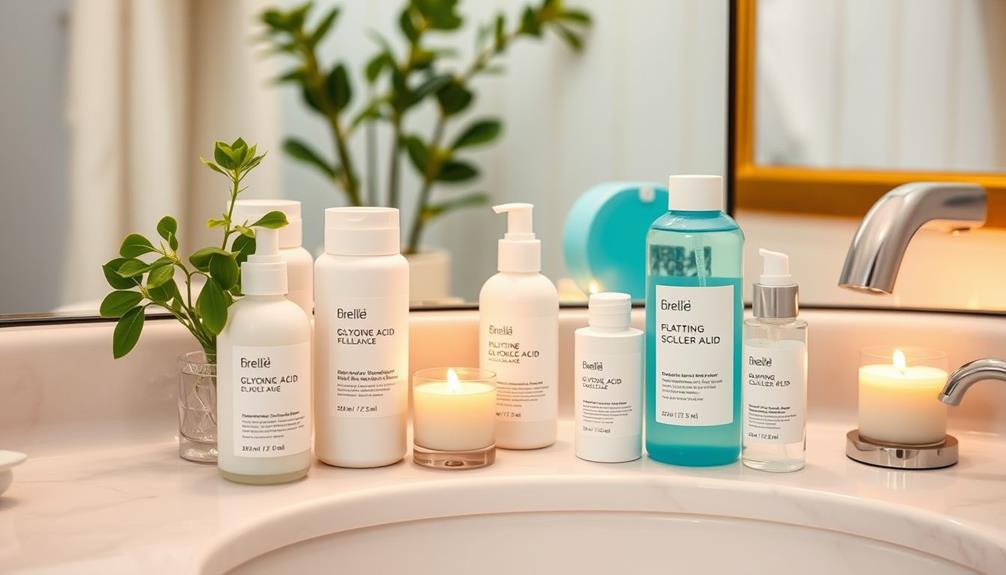
When you start incorporating glycolic acid into your skincare routine, it's important to know how to use it effectively.
You'll want to take into account daily application tips, how to layer it with other products, and keep an eye on how your skin reacts.
For best results, try to maintain a consistent schedule with your skincare, similar to how a consistent sleep schedule can improve overall health.
These steps will help you maximize the benefits while minimizing any potential irritation.
Daily Application Tips
To seamlessly incorporate glycolic acid into your skincare routine, start with a low concentration product applied once or twice a week to gauge your skin's tolerance.
As you assess how your skin tolerates glycolic acid, it's important to listen to your body and be aware of any signs of irritation, much like the principles of self-exploration through body awareness in somatic therapy.
Here are some daily application tips to follow:
- Choose the right product: Look for glycolic acid cleansers, toners, or serums that suit your skin type.
- Apply on dry skin: Make certain your skin is completely dry before application to prevent irritation.
- Evening routine: Use glycolic acid in the evening to minimize sun sensitivity and allow for overnight exfoliation.
- Moisturizer is essential: Always follow up with a gentle moisturizer to keep your skin hydrated and support the barrier, especially if you have sensitive skin.
Layering With Other Products
Incorporating glycolic acid into your skincare routine means understanding how to layer it effectively with other products for best results.
Start with lower concentrations, around 5%-8%, especially if you have sensitive skin. When applying glycolic acid, verify your skin is clean and dry to maximize its exfoliating effects without increasing irritation.
After applying glycolic acid, follow up with a gentle, fragrance-free moisturizer. This step is vital for maintaining skin hydration and barrier function, which helps soothe any irritation from the acid.
Be cautious about layering with other treatments; avoid combining glycolic acid with potent active ingredients like retinol or vitamin C on the same night to prevent excessive irritation. Instead, alternate their usage for best results.
Lastly, don't forget about sun protection. Using glycolic acid can increase your skin's sensitivity to the sun, so applying a broad-spectrum SPF 30 or higher every morning is critical. Reapply throughout the day to protect your skin from harmful UV rays while you're treating acne effectively.
Layering these products thoughtfully can lead to clearer, healthier skin.
Monitoring Skin Reactions
Monitoring how your skin reacts to glycolic acid is essential for achieving the best results without irritation. Especially if you have sensitive skin, taking a gradual approach can help you gauge your skin's tolerance. Start with lower concentrations, around 5%, and adjust the frequency of application based on your skin's response.
Here are some effective strategies to evaluate:
- Conduct patch tests on a small area to identify any adverse reactions.
- Monitor for irritation like redness or peeling to determine your skin's sensitivity.
- Increase the frequency of application slowly, starting with once or twice a week.
- Always apply glycolic acid to dry skin to minimize irritation.
Keeping a skincare journal can help you track the effects of glycolic acid, making it easier to adjust your routine when necessary.
Potential Side Effects

Glycolic acid can cause side effects like irritation, redness, and burning, especially for those with sensitive skin or when using higher concentrations. If you're new to glycolic acid, it's advisable to start with lower concentrations (5%-8%) and conduct patch tests to gauge your skin's reaction. This approach can help minimize the risk of side effects.
Increased sun sensitivity is another concern. Using glycolic acid can make your skin more susceptible to sunburn, so you'll need to apply broad-spectrum sunscreen daily to protect your skin. Be particularly cautious if you have darker skin tones, as there's a risk of post-inflammatory hyperpigmentation, which can occur if your skin isn't monitored closely during treatment.
Higher concentrations, especially in professional peels, can lead to significant irritation or even chemical burns if not applied correctly. It's crucial to follow product directions and consult with a professional if you're considering stronger treatments.
Comparisons With Other Acids
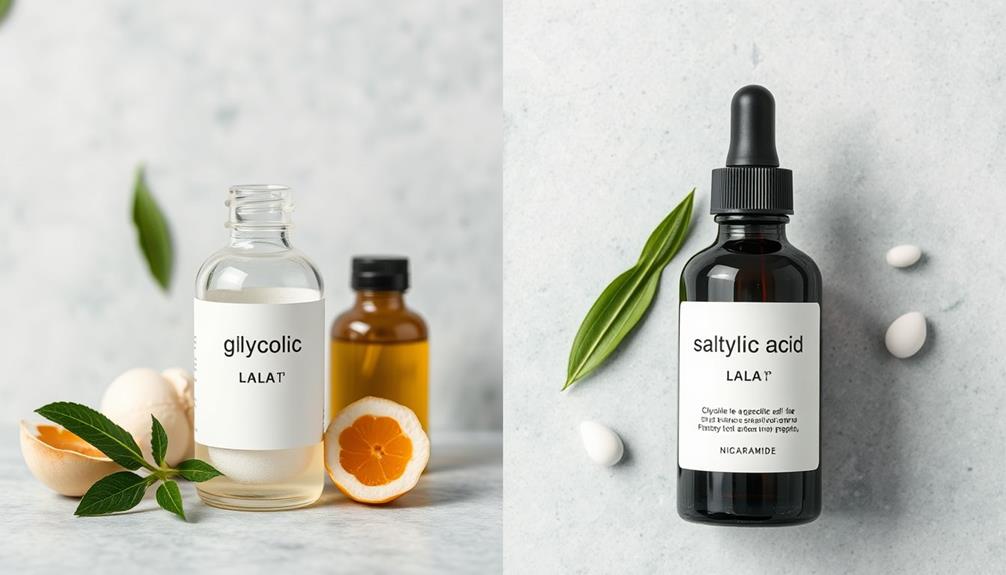
When choosing an acid for acne treatment, it's essential to weigh the differences between glycolic acid and other options like salicylic and lactic acid.
Glycolic acid, an alpha hydroxy acid (AHA), excels at exfoliation and improving skin texture. In contrast, salicylic acid, a beta hydroxy acid (BHA), dives deeper into pores, making it particularly effective for acne-prone skin by preventing clogged pores.
Here's how they compare:
- Glycolic Acid: Focuses on surface exfoliation, enhancing skin texture and tone.
- Salicylic Acid: Targets oily skin, dissolving excess sebum and debris to prevent breakouts.
- Lactic Acid: A gentler AHA suitable for sensitive skin types, offering hydration alongside exfoliation.
- Exfoliation Depth: Glycolic acid penetrates deeper due to its smaller molecular size, yielding quicker results.
Ultimately, your choice should depend on your specific skin concerns and sensitivity. If you prioritize overall skin texture and brightness, glycolic acid might be your go-to, while salicylic acid is ideal for tackling persistent acne issues.
Best Practices for Use
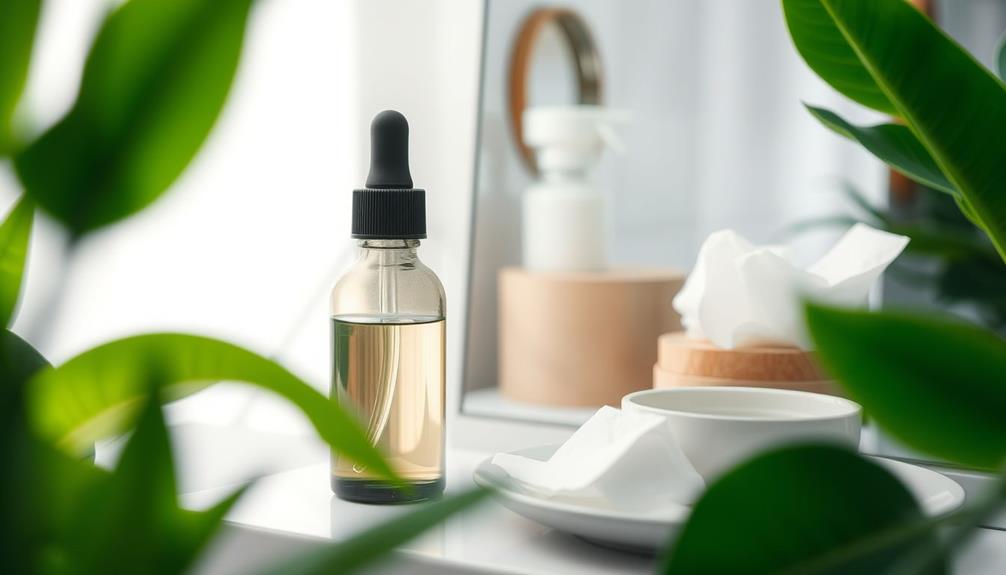
To get the best results from glycolic acid, start with a low concentration and gradually increase usage as your skin adjusts. This approach minimizes irritation, especially if you have sensitive skin. Begin with a product containing 5%-8% glycolic acid, applying it once or twice a week. As your skin adapts to the exfoliating effects, you can increase the frequency to daily use.
| Step | Action |
|---|---|
| Start | Use a low concentration glycolic acid |
| Apply | Use on dry skin, avoiding eyes and lips |
| Moisturize | Apply a gentle, fragrance-free moisturizer |
After applying glycolic acid, it's essential to incorporate a moisturizer to maintain hydration and support your skin barrier. Regular dermatologist consultations are also recommended to assess your skin's response and make any necessary adjustments to your acne treatment skincare routine. By following these best practices, you can effectively harness the benefits of glycolic acid while minimizing potential side effects.
Importance of Sun Protection
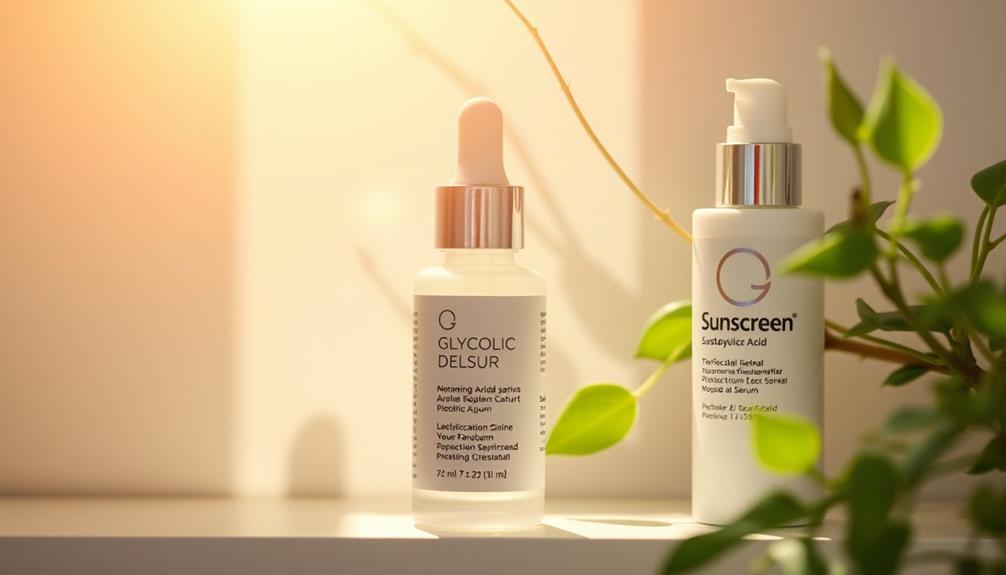
Using glycolic acid can considerably increase your skin's sensitivity to UV rays, making sun protection essential. When you incorporate this powerful acid into your skincare routine, it's important to shield your skin from potential damage.
Here are some key points to remember:
- Always apply a broad-spectrum sunscreen with an SPF of at least 30.
- Reapply sunscreen every two hours, especially after swimming or sweating.
- Consider using physical barriers like hats and long sleeves for added protection.
- Seek shade during peak sun hours to minimize UV exposure.
With glycolic acid increasing the risk of UV-induced inflammation and skin damage, these protective measures become even more critical. Daily sun protection not only helps prevent sunburn but also reduces the chances of developing long-term skin issues.
Personalized Skincare Consultations
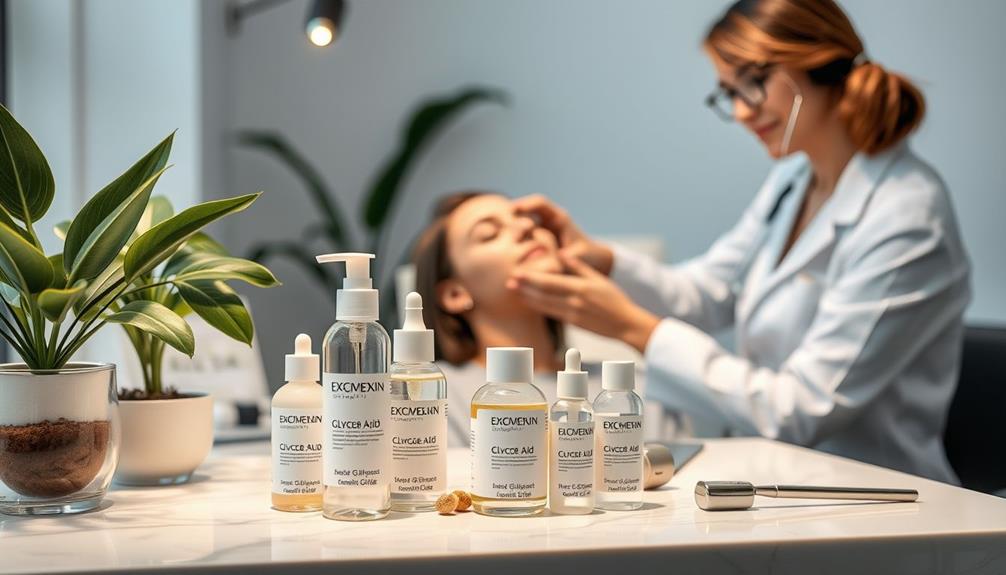
Personalized skincare consultations with dermatologists help you find the best glycolic acid products for treating your acne.
During these consultations, your dermatologist evaluates your skin type and the severity of your acne to determine the appropriate concentration of glycolic acid for your needs. This tailored approach guarantees you're using a formulation that effectively addresses your concerns without causing excessive irritation.
Incorporating glycolic acid into your skincare routine can be tricky, but a dermatologist can provide insights on how to do it safely. They'll consider any previous treatments or medications you've used, guaranteeing a safe and effective regimen.
Regular follow-ups are essential as they allow your dermatologist to monitor skin responses to glycolic acid and make necessary adjustments for the best possible results.
Frequently Asked Questions
Can Glycolic Acid Cure Acne?
Glycolic acid won't cure acne completely, but it can greatly reduce breakouts by exfoliating your skin and unclogging pores. Regular use may improve your complexion and help prevent future flare-ups, but results can vary.
What Do Dermatologists Say About Glycolic Acid?
Dermatologists recommend glycolic acid for its exfoliating benefits, helping unclog pores and reduce inflammation. It's particularly effective for mild to moderate acne, but consulting a professional can tailor treatments to your specific skin needs.
How Long Does It Take Glycolic Acid to Work on Acne?
When it comes to glycolic acid, you'll likely notice improvements in your skin within 4 to 6 weeks. Stick with it, and you'll see how it helps clear your acne and improve overall texture.
Does Glycolic Acid Help Hormonal Acne?
Yes, glycolic acid helps hormonal acne by exfoliating your skin, unclogging pores, and reducing inflammation. Start with a low concentration to see how your skin reacts, then gradually increase for ideal results.
Conclusion
Incorporating glycolic acid into your skincare routine can be a game changer for acne management.
Studies show that over 75% of users experience clearer skin after consistent use.
By enhancing cell turnover and reducing clogged pores, glycolic acid helps you achieve a smoother complexion.
Just remember to pair it with sun protection, as it can increase your skin's sensitivity.
Consulting with a dermatologist can help tailor the best approach for your unique skin needs.










